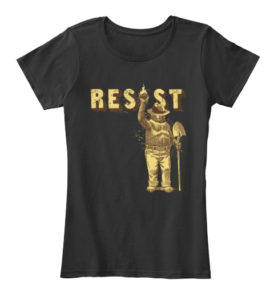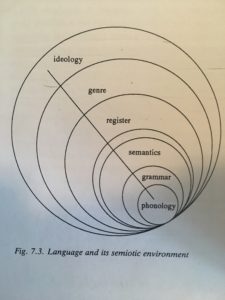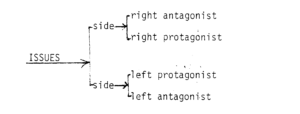Hall, S. (1993). Encoding, Decoding. In S. During (Ed.), The Cultural Studies Reader (pp. 90-102). London and New York, NY: Routledge.
In “Encoding, Decoding” Stuart Hall lays the groundwork for a contextualized theory of communication. Hall (1993) argues that for too long communication has been conceptualized as “a circulation circuit or loop. This model has been criticized for its linearity—sender/message/receiver” (p. 91). In response to this reductive model of communication, Hall offers a semiotic paradigm consisting of several determinate, yet interconnected, moments: “production, circulation, distribution/consumption, reproduction” (p. 91). This semiotic paradigm models the complex social relations involved in the production, circulation, consumption, and reproduction of televised discourse while accounting for misunderstandings that can arise from asymmetrical power relations between television producers and viewers. From the determinate moment of production, the power and social relations of professionals yield a code that is encoded in the discursive message of a televised broadcast. This message is eventually decoded by viewers, becoming embedded in social relations and, in turn, feeding back into the moment of production. Some codes appear to be so universal they are naturalized, taken for granted as common sense. This naturalization process has tremendous ramifications in terms of ideology, as the naturalization of codes “has the (ideological) effect of concealing the practices of coding which are present” (p. 95). Hall also makes the distinction between the denotative and connotative level of a message. At the analytical level, the denotative meaning is the literal “fixed” meaning of a sign, while the connotative meaning refers to the polysemic, open, or associative and, hence, ideological level of the sign. However, Hall is quick to point out that the denotative level is not immune to ideology. For new ideological meanings to become naturalized they must first be mapped onto new discourses that are “preferred,” preferred meanings having the backing of the dominant power structure. Hall outlines three possible subject positions for decoding meaning. The dominant hegemonic position interprets a message at its face value. The viewer receives the message exactly as the producers intend it. In the negotiated position, the viewer receives the dominant or preferred meaning, but partially contests it at some level, usually at its local application. Finally, in the opposition position, the viewer completely rejects the dominant message, instead interpreting the message from an alternative ideological framework, such as seeing the message as promoting the interests of a specific class.
Hall’s semiotic paradigm is still the most fully conceptualized model of mass communication. What makes the model so powerful is that it allows for the power dynamics, social relations, and discursive rules within the semiotic chain—from production to distribution to consumption to reproduction—to be analyzed at each determinant moment. Instead of a reductive behavioral model, which posits that a discursive message, say for instance about violence, would actually promote violence, Hall’s model is capable of analyzing the underlying social dynamics and power dynamics that generate visual discourse. The semiotic paradigm is also able to account for “misreadings” between production and consumption, as well as analyze the role the media establishment plays in the naturalization of ideologies as common sense.
In terms of my research, Hall’s semiotic paradigm allows me to link visual texts to their social contexts or culture in a dialectical way. Additionally, the model helps analyze visual texts at stratified levels, including their denotative “natural” level and their connotative, ideological level, while being able to situate visual texts intertextually. From the article, it is uncertain whether Hall foresaw the rise of user-generated content or alternative media. New media brings up several questions in terms of the application of Hall’s model, including how it is applied to the subject position of viewers. Although most social media activism is coded as revolutionary, as Marx noted, “The ideas of the ruling class are in every epoch the ruling ideas.” So, messages coded as revolutionary on social media may be, in fact, still operating from a dominant hegemonic position, whereas alternative media most likely operates strictly within an opposition code. Applied to a contemporary context, Hall’s work shows an increasing polarization between the dominant and opposition codes, with less space for a reasonable negotiated position. Although Hall may not have predicted the rise of social and alternative media, his theory still accounts for it, as user-generated content feeds back into the professional moment of production.



